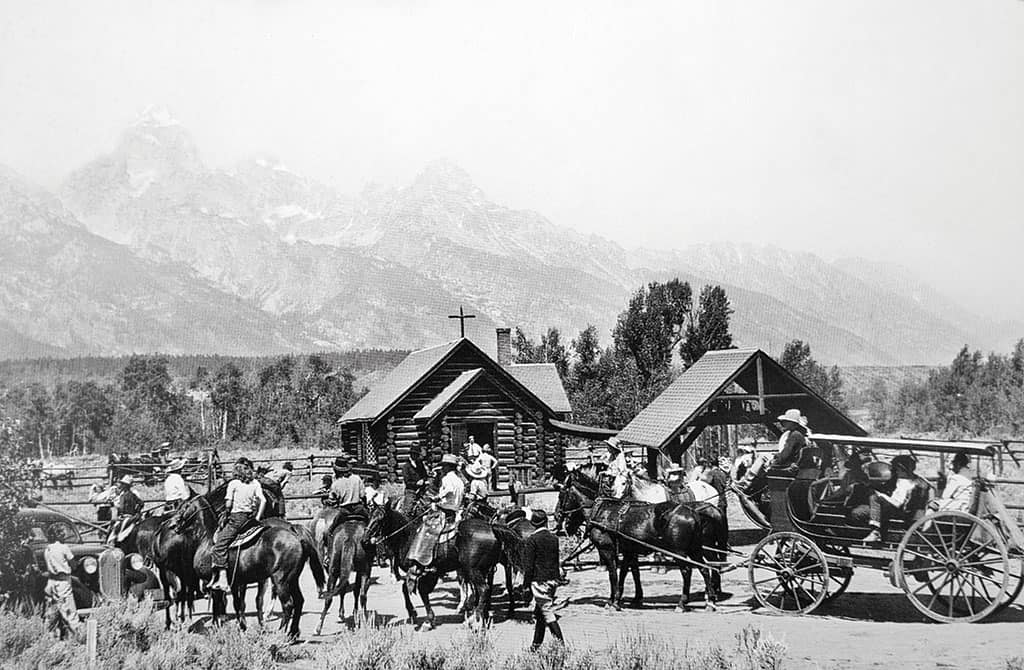Read The
Current Issue
Chapel of the Transfiguration
Religion is not required to enjoy this historic chapel.
By Molly Loomis

“No wonder the hills and groves were God’s first temples … ” – John Muir
WORSHIP TAKES MANY forms in the Tetons, whether it’s climbing one of the Cathedral peaks (The Grand Teton, Teewinot, and Mount Owen), sitting quietly by the Snake River, or, more traditionally, with a service at the Chapel of the Transfiguration in Moose.
Nearly a century old, the chapel was born out of Leigh Lake summer residents’ frustration at making the bumpy commute every Sunday to the Episcopal Church in Jackson. One Sunday in 1923 served as the final straw: a broken Menor’s Ferry meant the faithful had to detour on the treacherous and longer Moose-Wilson Road.
MAUD NOBLE, AN early homesteader who lived in the area, enthusiastically donated land for the project, and other residents took to fundraising and finding an architect. Inspired by Our Father’s House in Ethete, Wyoming, which was built several years earlier (1919) and had windows framing a view of the Wind River Mountains, the Chapel of the Transfiguration was built in western Craftsman style by unknown carpenters, most likely dudes on area ranches. It was completed in 1925 and got its name from a verse in the Bible’s New Testament, Mark 9:2-13. The verse recounts when Jesus led three of his disciples into the mountains and transformed before their eyes. “You look at those mountains in the background and you see more than meets the eye,” says the Rev. Frank Johnson, a former rector of St. John’s Episcopal Church in Jackson who today oversees the chapel.
Designated on the National Register of Historic Places in 1980, the chapel’s interior and exterior, bell tower, and lychgate are all original. Columns did have to be added for structural support. In 2006 an expanded bride’s cabin was added, and every ten to fifteen years the buck and rail fence needs replacing.
THE DAYS OF cowboys on horseback and wagons filled with visiting dudes racing to get to chapel on time are over, but still the Chapel of the Transfiguration’s two Sunday services—only held in summer, per tradition—draw upwards of seventy-five people. The rest of the year it hosts Christmas, Easter, and Valentine’s services for the warmly dressed. (Valentine’s Day is especially for couples wanting to renew their vows.) In addition, about forty couples get married at the chapel every summer, and The New York Times noted the chapel is one of the country’s best small churches to get married in.
Recently retired rector the Rev. Ken Asel estimates nearly 50 percent of the congregation is local. Although the chapel is Episcopalian, Father Asel emphasizes that “everyone is encouraged to participate as they feel comfortable. Of all the aspects of religion, belief is the least important. Far more important than the intellectual beliefs is furthering good.”
FOR THE LAST fifteen years, the chapel has hosted visiting clergy from Episcopal churches across the United States and in the United Kingdom. Father Johnson, who is working on a book about the history of the Episcopal Church in the valley, says that no matter where you’re from it’s hard to stand in a place like the Chapel of the Transfiguration without crafting a sermon that references what’s outside the windows. After all, there’s not much between the glass and the great outdoors. Over the years, moose, bear, elk, badger, and lots of bats have participated in services in one way or another. There was even a chiseler that once ran over an unsuspecting bride’s dress. Johnson says that, true to place, there’s a Wyoming liturgy for Communion that ties the Lord’s Supper to the natural surroundings.
Services are 8 a.m. and 10 a.m. Sundays from Memorial Day through Labor Day. Call St. John’s Episcopal Church at 307/733-2603 for additional information and details about holiday services.





